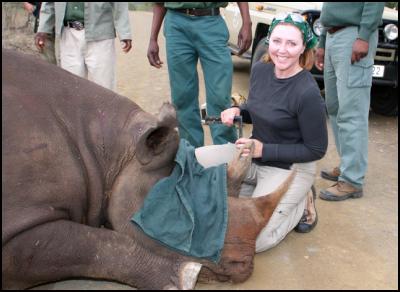Helping to save the rhino
14 January 2014
Helping to save the rhino
Research from Victoria University has revealed a way to help secure the future of an endangered species of black rhinoceros in South Africa.
Rosalynn Anderson-Lederer, who spent six months working with black rhino in KwaZulu-Natal province in south-eastern South Africa, looked at how quickly genetic variation is being lost in the endangered rhino population and discovered that the decline can be slowed, and possibly reversed.

Click for big version.
“Simply by bringing in a pair of rhinos, one male and one female, from other parts of Africa once every generation, so once every 14 years, genetic variability can be increased,” she says.
Rosalynn, who recently graduated from Victoria University with a PhD in Cell and Molecular Bioscience, says that high levels of genetic variability are important to improve chances of survival.
“If a species has low levels, it should be able to survive slight to moderate changes to the environment, or disease or injury, but may not be able to survive if it encounters more than one of these things at the same time. Species with higher levels of genetic variation tend to thrive better.”
Studies have shown that, overall, species with low levels of genetic variability are at greater risk of extinction than those with high levels.
“If genetic variation loss in endangered populations can be slowed down, it could give the population a chance to adapt to future changes in the environment or diseases,” she says.
Rosalynn, originally from San Diego, went to South Africa in 2008 and 2009, for three months at a time, to collect genetic material from the black rhinoceros.
“To bring down a black rhino in order to collect blood and tissue is an amazing feat,” she says. The rhino has to be identified from a helicopter and then “darted” with an anaesthetic.
“Once the rhino stops you have to act quickly as its metabolism is quite delicate. The veterinarian is careful and if the rhino shows any signs of distress they reverse the anaesthetic.
“If the rhino is breathing normally and sleeping, you have 20 minutes from start to finish to take enough blood and tissue and to get a radio transmitter in the horn.”
Back in Wellington, she spent a number of months testing the samples in the lab. “Extracting DNA can take anywhere from several hours to a few days, depending on how you extract it. With an endangered species, you have a limited number of samples to work with,” she adds.
The management of genetic variation is important for species that depend on human intervention for survival.
“There a number of species, both plant and animal, which would be extinct if not for human intervention,” says Rosalynn, “and there is something very rewarding about finding something that is going to help an endangered species.”
ENDS


 John Mazenier: Gaffer Tape And Glue Delivering New Zealand’s Mission Critical Services
John Mazenier: Gaffer Tape And Glue Delivering New Zealand’s Mission Critical Services Earthquake Commission: Ivan Skinner Award Winner Inspired By Real-life Earthquake Experience
Earthquake Commission: Ivan Skinner Award Winner Inspired By Real-life Earthquake Experience Reserve Bank: Consultation Opens On A Digital Currency For New Zealand
Reserve Bank: Consultation Opens On A Digital Currency For New Zealand NIWA: Ship Anchors May Cause Extensive And Long-lasting Damage To The Seafloor, According To New Research
NIWA: Ship Anchors May Cause Extensive And Long-lasting Damage To The Seafloor, According To New Research New Zealand Customs Service: A Step Forward For Simpler Trade Between New Zealand And Singapore
New Zealand Customs Service: A Step Forward For Simpler Trade Between New Zealand And Singapore Horizon Research: 68% Say Make Banks Offer Fraud Protection
Horizon Research: 68% Say Make Banks Offer Fraud Protection



